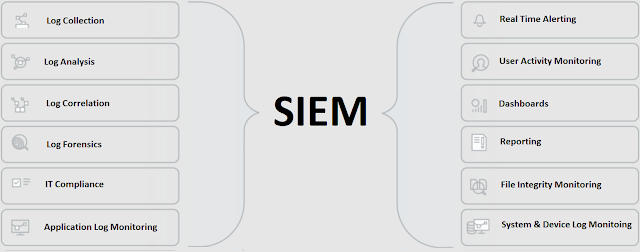SIEM tool is the heart of the modern SOC. For most of the security processes SIEM tool lays the foundation and saves the effort of all security analysts. SIEM brings in a huge amount of log data from many different assets which belongs to the organization.
SIEM Security is nothing but the integration of all security tools, monitoring tools, servers, cloud workloads and endpoints to SIEM solution. A SIEM tool collects log data and event data from all the systems, analyze and generate alerts when there are any suspicious activities identified which can lead to a security incident.
All SIEM solutions have three main stages:
1. Data Collection - Collecting log and event data from all the assets of organization - systems, devices, endpoints, apps, security tools, network devices, etc.
2. Data Consolidation - Normalizing and categorizing the collected raw data which can be used by soc analysts to perform analysis. Categorizing data can be done by using origin of the user, systems accessed, credentials, performance and more.
3. Data Analysis - Normalized and categorized data is analyzed and is checked for abnormal or suspicious events which raises an alert on SIEM tool.
Evolution of SIEM:
First Gen SIEM - Introduced in 2005, combination of SIM and SEM. It can process only limited scale of data and generate sophisticated alerts and visualizations.
- LMS - Log Management Systems: Collection and storage of log data.
- SIM - Security Information Management: Automation tools used to collect log data. Long-term log data storage, analysis and reporting on collected log data.
- SEM - Security Event Management: Real-time monitoring and correlation of systems and events with dashboard view and notifications.
Second Gen SIEM - They can consume large volumes of data and can handle big data of historical logs. These second generation SIEMs can correlate historical log data with real time events and data from threat intelligence feeds.
Third Gen SIEM / Next Gen SIEM - Proposed by Gartner in 2017. Two new technologies are integrated with these SIEMs - UEBA and SOAR. User and Entity Behavior Analytics (UEBA) uses Machine Learning (ML) in establishing behavioral baselines of all users, systems, endpoints, apps, tools which helps in identifying any anomalies. Security Automation, Orchestration and Response (SOAR) helps analysts in quickly investigating incidents and automate response in case of a event.
Importance of SIEM:
SIEM tool importance in organizations:
- Log management, case management.
- Compliance regulations - PCI DSS, PII, HIPAA, SOX, etc. and policy enforcement.
- Security monitoring, incident response.
- Threat Intelligence
- Data Intelligence
- Disaster Recovery
- Normalization and Categorization of log data.
- Analyzing, alerting and reporting.
Next Gen SIEM Features:
Third Gen SIEM solutions offers some new features:
- UEBA - Advanced users / entity behavior analytics which can detect anomalies by monitoring behaviors of users and entities in organization. SIEMs with UEBA use cases:
- Compromised Insider
- Malicious Insider
- Data Loss Prevention
- Alert Triage
- SOAR - Automation and orchestration of incident response.
- Dashboards and Visualizations.
- Long term data retention and unlimited scalability.
- Flexible searching, querying, reporting, and data exploration.
- Threat hunting interface.
- Forensic Analysis

Comments
Post a Comment